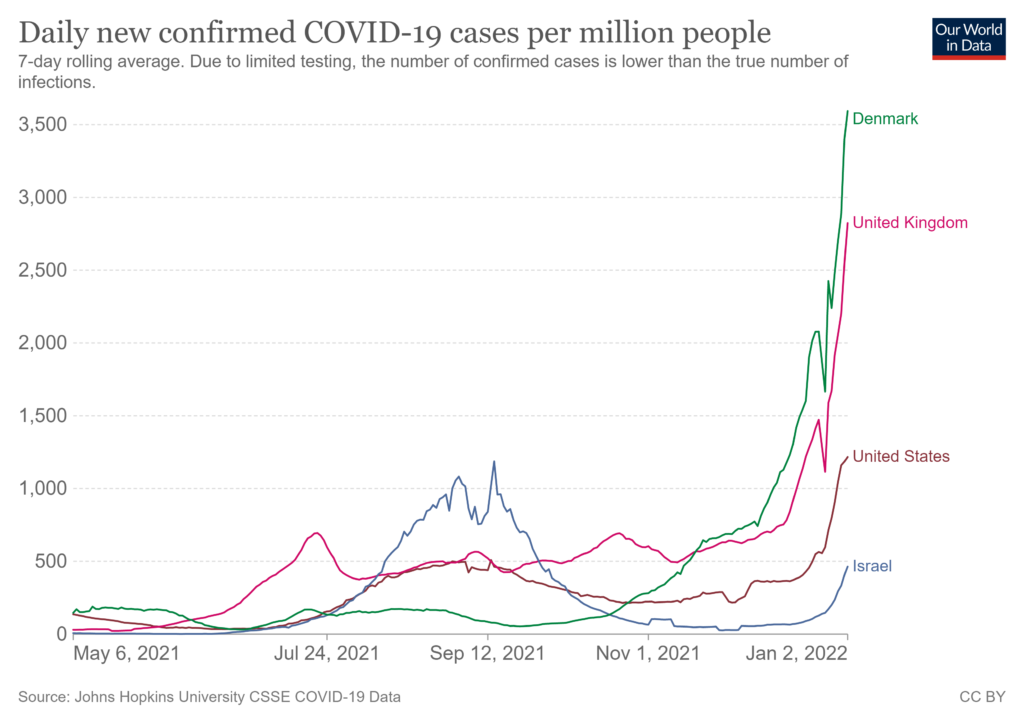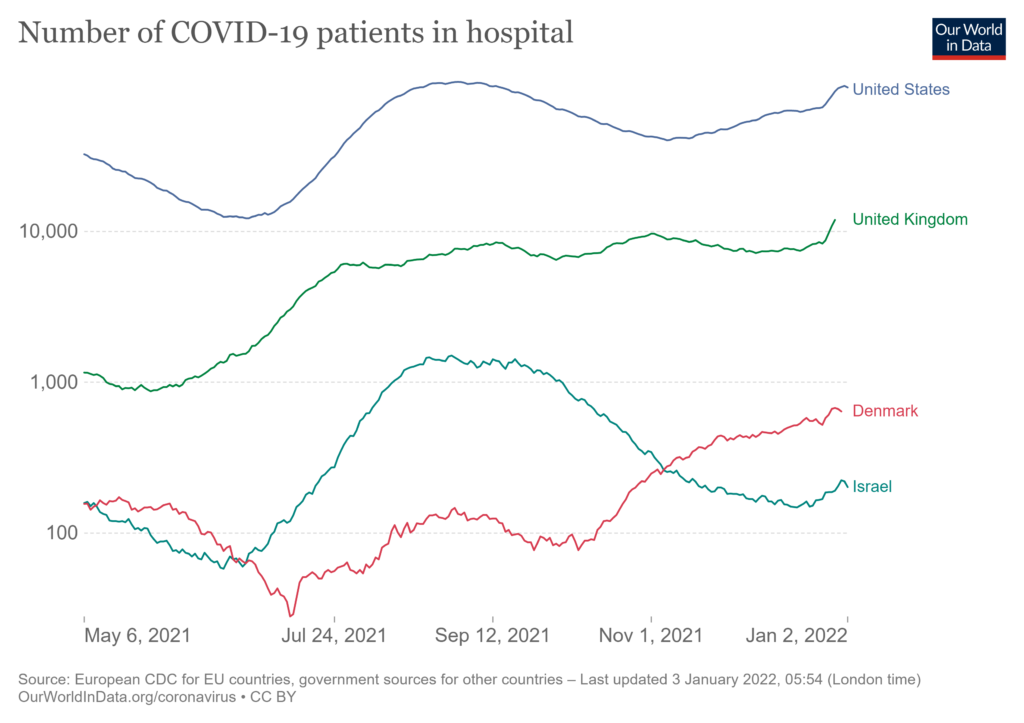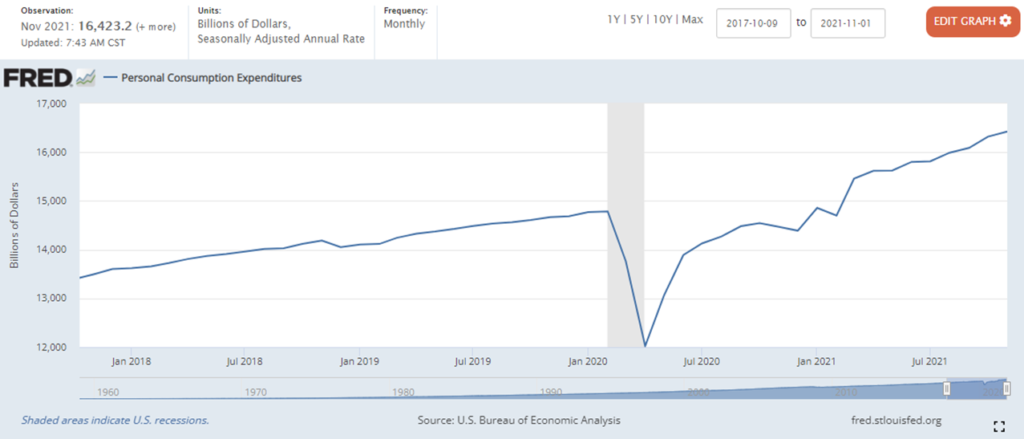Intellectually most of us accept the complexity of everyday life. Emotionally most of us prefer clarity. The tension between complexity and clarity is at the heart of most human stories — comedies and tragedies and each of our daily dramas. Integrating what we carefully discern with what we spontaneously feel and then doing something constructive can be treacherous. Below is a bit of comedy that, at least to my taste, acknowledges both what is real and our preference for something less complicated. Please listen long enough to hear Colbert sing (about 100 seconds in).
Category: Uncategorized
Clarifying CDC quarantine and isolation recommendations
Late Tuesday afternoon, the CDC clarified its recommendations released on December 27. The document (available here) provides more context and condition-specific detail. Accurate public health guidance — especially for a fast-moving, highly-contagious, mutating virus — will not always provide practical workplace guidance.
For most supply chain professionals, here are my reductionist interpretations for the workplace.
Vaccinated, boosted, and asymptomatic workers who come into close contact with someone with covid do not need to quarantine. For ten days after close contact, vaccinated, boosted, asymptomatic workers should wear a well-fitting mask around others.
Non-vaccinated, non-boosted workers — without symptoms — should quarantine for at least five days after close contact with covid… and then follow the specific steps set out in the recommendation before returning to work.
When anyone has symptoms of covid and/or tests positive, s/he should isolate… and then follow the specific steps set out in the recommendation before returning to work.
Vaccinated, boosted workers do not need to test-out of isolation. (The reasons outlined in the clarified recommendation are consistent with what Dr. Walensky told Colbert on Monday night.) Some states still have public health orders in place that require testing-out of quarantine and isolation. Current demand for testing far exceeds supply.
In my personal judgment, many previous good practices to reduce transmission have been overcome by events, overcome by omicron’s extremely contagious character.
If sick, stay home. If vaccinated, boosted and feeling fine, please come to work, you are needed. You will be needed even more over the next two or three weeks as the number of new infections skyrocket and many of your co-workers should not or cannot work. Given omicron’s rush and reach, you should wear a mask when working with others.
On December 27 OSHA announced changes in its stance. The Supreme Court is scheduled to hear related oral arguments this Friday. I do not expect OSHA standards to be significantly clarified prior to peak-omicron.
As stated previously (before any of the recent CDC recommendations), I am not a lawyer or epidemiologist. I am someone who wants to safely facilitate continued flow of water, food, pharmaceuticals, fuel, and other critical freight. This is never risk-free work. I recognize the profound risks involved if flows are seriously disrupted. How do I behave as a prudent person with a fundamental duty to fulfill… during a pandemic? How do I do my best to serve others with what is available? How do I square necessity with possibility?
Colbert and Walensky in Conversation
Last night Stephen Colbert talked through isolation and quarantine practices with CDC Director Dr. Rochelle Walensky. By mid-morning today, several media outlets are suggesting a “clarification” of testing-out of isolation/quarantine is under consideration. (See Reuters report)
Three week countdown
“This is not the same disease as we were seeing a year ago,” according to Sir John Bell, professor of medicine at the University of Oxford, discussing the omicron variant’s impact on covid. Infections are skyrocketing (see first chart below), but symptoms are often milder and hospitalizations — while rising — are increasing at a much lower rate than with prior dominant variants (see second chart below).
The data subtext for these case counts can be treacherous. Israel and Denmark have sophisticated real-time data-streams on new cases. UK data sources are almost as good. US case counts are much less accurate, especially after a long holiday. But Denmark’s sudden surge last week reflects social behavior and easy access to testing as much as infection rates. Especially in the context of omicron, hospitalizations are a more confident comparative measure.
Risks to the healthcare system — and other crucial networks — continue to be significant. While hospitalization rates are much lower, infections are much higher. The lower rate can still generate significant new admissions. Many US hospitals are already short-staffed. Several key supply chains have been struggling to keep and recruit sufficient workforce levels before omicron emerged (more). Strict adherence to isolation and quarantine guidance could decimate flow capacity.
Widespread omicron contagion can now be assumed. Spread and depth of disease is still to be seen. Cascading impacts on supply chain capacity should roughly track disease penetration across the population. Watching how, when, and where constraints on flow emerge may provide helpful hints on potential mitigation measures. This is what I will watch and update here over the next three or so weeks.


Monitoring M2 in 2022
For tedious — even tendentious — reasons, I have resisted consistent attention to movement in the M2 money supply measure. In my mind (until now) M2 moved this supply chain guy too far from assessments of demand and supply and too deep into economic analysis. My supply chain competence is arguable. My economic expertise is execrable.
So, this conversation has given ongoing attention to retail sales and occasional attention to the personal saving rate and to debt payments as a percentage of disposable income. I will continue to monitor and report on these indicators. (Here’s a recent example.)
But, I have decided that even a supply chain guy must now embrace the M2 explosion and try to update my half-century old (pseudo-) understanding of classical monetary theory — and profound uncertainty regarding Modern Monetary Theory (and here and here). I take this step with real reluctance and even regret. But because high volume, high velocity supply chains self-organize around demand, the persistent increase and influence in M2 (see below) can no longer be neglected.
When M2 continued to grow despite strong holiday sales, I finally decided “attention must be paid” to M2 as a meaningful signal of how and when we may reclaim something closer to demand-supply equilibrium.
You will see me struggle. I welcome questions, corrections, clarifications, and even, when possible, confirmations.

What happens when flow is stopped
In the December 29 Wall Street Journal there is a helpful visual animation of how recent supply chain disruptions share characteristics of a traffic jam. The metaphor is especially apt for the sudden diminution of global flows in February to May 2020. In my judgment the animation underplays further disruption prompted by increased demand (especially for durable goods) in the 18 months since.
CDC revises quarantine recommendation
On Monday afternoon the CDC recommended a new set of mitigation measures for individuals potentially exposed to or infected with SARS-CoV-2. The revisions reflect what is now known about the omicron variant and protections provided by vaccines. The full recommendation can be found here.
Of particular relevance to many supply chain professionals is the following excerpt from the CDC statement:
If You Were Exposed to Someone with COVID-19 (Quarantine)
If you:
Have been boosted
OR
Completed the primary series of Pfizer or Moderna vaccine within the last 6 months
OR
Completed the primary series of J&J vaccine within the last 2 months
- Wear a mask around others for 10 days.
- Test on day 5, if possible.
If you develop symptoms get a test and stay home.
The recommendation is appropriately contextual and conditional. Different risk-factors justify a differentiated response. But… in other words, if a boosted or recently vaccinated person has been exposed to infection but remains asymptomatic, no work restriction is recommended.
Testing is recommended “if possible”. This CDC language recognizes that over the next few — crucial — weeks, testing supplies may not fulfill demand created by omicron’s rapid spread. The CDC statement also includes: “For all those exposed, best practice would also include a test for SARS-CoV-2 at day 5 after exposure.” The use of that modal verb — would — is not accidental, and implies uncertain ability or likelihood for a whole host of reasons, including being asymptomatic and unaware of exposure.
Most media have so-far headlined other elements of the CDC statement (here and here and here), focusing on the isolation period for a confirmed case being reduced to five days.
As outlined in prior posts (here and here), the speed and severity of omicron’s spread could result in flows of food, fuel, pharmaceuticals, and other crucial freight depending on vaccinated and boosted workers who test positive but remain asymptomatic continuing in their roles. The CDC language recognizes that until testing is much more widely available this will sometimes be the practical outcome.
Friends and colleagues operating supply chains note that vaccination rates among their workforces are lower than the national average. If vaccine mandates are imposed, they are concerned a significant portion of their already tight workforces will walk away. If so, flow through their nodes and channels will narrow… potentially dramatically. So, this important CDC decision does not resolve current or prospective supply chain challenges. But this CDC revision does reduce constraints not well-matched with omicron’s risk for those who are vaccinated and boosted.
Preserving flows while omicron grows
On Christmas eve about 700 commercial flights serving US routes were canceled, on Christmas day another 900 plus, yesterday (Sunday) there were more than 600 cancelations (more and more). As of 5AM (eastern) today, 700 plus flights have been scrubbed. This is part of a significant global uptick. Positive covid tests for pilots, flight attendants and other air transport personnel are being blamed for a large portion of cancellations. The highly contagious omicron variant is suspected in a sharp increase in confirmed cases among flight crews.
There is no reason to assume that infections are less prevalent among workers in other production, processing, distributing, and delivery sectors, for example: health care, public water systems, food, fuel, pharmaceuticals, medical goods, and related freight operators.
Recognizing the fast moving threat, on December 23 the CDC amended its isolation guidance for Health Care Personnel. The detailed amendment includes this summary:
In general, asymptomatic HCP who have had a higher-risk exposure do not require work restriction if they have received all COVID-19 vaccine doses, including booster dose, as recommended by CDC and do not develop symptoms or test positive for SARS-CoV-2. The duration of protection offered by booster doses of vaccine and their effect on emerging variants are not clear; additional updates will be provided as more information becomes available.
This change recognizes that given omicron’s transmission velocity and ability to evade prior immunity, lengthy periods of workforce isolation or quarantine could decimate health care capacity.
The CDC continues to recommend that workers who are not Health Care Personnel quarantine for seven to ten days after potential exposure to a confirmed case. This differentiated approach is intended to minimize risks of transmission. The more contagious people circulating, the higher the risk of rapid and widespread transmission.
Given the wanton velocity of omicron’s transmission patterns, is this prudent principle still appropriate?
Early assessments suggest that omicron is much more contagious than prior variants, with case counts doubling every three days or less (here and here and here). If these early findings are accurate, there is no reason to assume that other sectors and flows do not face capacity risks similar to those facing health care. CDC decision-makers are more personally familiar with the work-force capacity risk in health care. But just as physicians, nurses, and medical technicians are needed, so are food processors, distribution center selectors, truck drivers and the other folks who keep us fed, fueled, and functioning.
Without this network of networks — these interdependent workers and functions — continuing to operate at scale, holiday travel is not the only flow about to be disrupted.
The revised CDC recommendation for Health Care Personnel recognizes that IF a worker is vaccinated/boosted and IF a worker is asymptomatic, then even with a high-risk exposure “work restriction” is not required… unless s/he tests positive. Other long-proven transmission mitigation measures (e.g., masking, physical distance, ventilation, etc.) are encouraged. Given omicron’s transmission rate, there is a reasonable case for this same flexibility being extended to workers in other sectors.
These last few days of troubled air travel signal that even more flexibility may be needed soon. Most of the pilots and flight attendants testing positive are vaccinated and asymptomatic. Many are boosted. But because they are testing positive, CDC recommendations and related industry policies have resulted in at least seven days away from work. The result is canceled flights, reduced flows, and other predictable bottlenecks and back-ups. The air travel industry is requesting no more than five days of isolation.
If omicron is as contagious and effective at evading immunity as early studies indicate (more and more and more), even five days isolation could erase an untenable proportion of flights, freight deliveries, food processing, and more high volume, necessarily high velocity flows. Temporary and quickly recurring loss of velocity can have long-term and wide-spread disruptive impacts on such networks… as we have often seen in the last two years.
If 90-some percent of omicron-related infections and re-infections result in mild symptoms or no symptoms, when, where, and how should asymptomatic, vaccinated, and boosted workers be able to continue without isolation or quarantine?
I certainly want to acknowledge each of the “ifs” noted above. But now is the time to ask and answer, if then: what, when, where, and how?
Consumption continues to climb
The November report on US Personal Consumption Expenditures shows another post-pandemic high, ten percent above the February 2020 PCE (as shown on chart below). This is, in my opinion, at least 500 billion more dollars per month in spending than any reasonable person would have predicted pre-pandemic. Until spending settles some there will continue to be price increases and occasional gaps between demand and supply (despite all efforts to calibrate). One tenuous sign of eventual reduced demand is a slight decline in the personal saving rate for November compared to month prior. (See related analysis of the November retail sales report.)

Mild for most, but…
Every variant of SARS-CoV-2 has produced mild symptoms in most of those infected. By now many of us — perhaps most of us (who do not live in New Zealand or Tonga) — have been infected but have remained asymptomatic (or barely symptomatic) and don’t even recognize our encounter with covid. But for two to three percent of those infected, results have been much more difficult, even life-ending.
There is accumulating evidence that — so far — the earliest encounters with omicron produce modest morbidity — especially when people are vaccinated. Here (again) is the most recent study out of South Africa. Here are two just-released studies from the United Kingdom, one from the University of Edinburgh and a second from Imperial College (London). I cannot yet find original source material for an analysis just completed of omicron cases in Denmark, but here is a helpful overview of three of these four reports (including Denmark’s) in this morning’s Financial Times.
In most places for most people individual risk of omicron causing serious covid is no worse or less than previously. People who are vaccinated have reduced risk. People who are boosted have very low risk of experiencing serious disease.
But omicron is very contagious, the most contagious variant yet. Omicron has also demonstrated a rather amazing ability to re-infect those with prior immunity (natural or vaccinated). Even if the hospitalization rate for omicron is the same or a bit less than prior variants, omicron’s transmission rate could push the health care system over the edge. A two percent hospitalization rate for 300 million cases will cause six-times the hospitalizations of two percent for 50 million.
Which is just a long way of saying, epidemics are less about individual risk than population risk. I am well over sixty, but otherwise my individual risk profile for serious disease is modest. I wear a mask, keep my distance, and minimize circulation to protect others from me. Mass vaccination does have individual benefits, but mass vaccination is especially important to manage risks for the most vulnerable among us. I am — all of us are — potential hosts and mutation factories for viruses. We will continue thus until we have suppressed SARS-CoV-2 worldwide. In most cases, our personal risk to this virus is negligible. But to reduce the risk to the most vulnerable — and those who are called upon to care for the most vulnerable — I want to do what I can.
There are obviously epidemiological and ethical implications here. I also perceive supply chain implications. Supply capacity is almost always the outcome of expensive long-term investments… for example in clinical facilities, pharmaceutical innovation… manufacturing… distributing, extensive professional education, and much, much more. Certainly, we want to build-in buffers for variation in demand. But there is seldom an affordable, reasonable way to develop supply capacity for a sudden doubling or more of well-established large-scale demand. So, I want to do my part to reduce demand on an already stressed system.